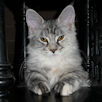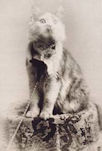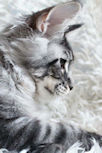Maine Coon Cats
History

The ancestral origins of the Maine Coon are unknown but there are a few myths and possibilities that are interesting.
A wide-spread myth is that it originated from matings between semi-wild, domestic cats and raccoons.
This was bolstered by the bushy tail and the most common coloring, a raccoon-like brown tabby, which led to the adoption of the name Maine Coon.
This myth is biologically impossible as the Racoon and the feline can not inter-breed.
Another tale involves Marie Antoinette, the Queen of France, who was executed in 1793.
The story goes that before her death, Antoinette attempted to escape France with the help of Captain Samuel Clough.
She loaded Clough's ship with her most prized possessions, including six of her favorite Turkish Angora cats.
Although she did not make it to the United States, her pets safely reached the shores of Wiscasset, Maine,
where they bred with other short-haired breeds and developed into the modern breed of the Maine Coon.
Then there is Captain Charles Coon, an English seafarer who kept long-haired cats aboard his ships.
Whenever Coon's ship would anchor in New England ports, the felines would exit the ship and mate with the local feral cat population.
When long-haired kittens began appearing in the litters of the local cat population, they were referred to as one of "Coon's cats".
Yet Another idea is that the Maine Coon originated from the matings of domestic cats and wild bobcats,
which could explain the tufts of hair that are so commonly seen on the tips of the ears. The problem with this is the lack of a tail in the bobcat.
Bobcats can breed with domestic cats so who really knows for sure.
The generally accepted hypothesis among breeders is that the Maine Coon is descended from the pairings of local short-haired domestic cats and
long-haired breeds brought overseas by English seafarers (possibly by Captain Charles Coon) or 11th-century Norsemen.
The connection to the Norsemen is seen in the strong resemblance of the Maine Coon to the Norwegian Forest Cat,
another breed that is said to be a descendant of cats that traveled with the Norsemen.
First Show Cat

In 1895, a dozen Maine Coons were entered into a show in Boston. On 8 May 1895, the first North American cat show was hosted at Madison Square Garden in New York City. A female Maine Coon brown tabby, named Cosey, was entered into the show. Owned by Mrs. Fred Brown, Cosey won the silver collar and medal and was named Best in Show.
About Maine Coons

A Maine Coon is a big rugged cat with a smooth shaggy coat. A medium-size to large
cat with a well-proportioned body that is muscular and broad-chested.
A Maine Coon has substantial, medium-length legs and large, round paws,
well tufted with fur, to serve as snowshoes during winter.
The most important features are the head, body shape and texture of their coat.
A heavy coat is shorter on the shoulders, longer on the stomach and britches (long fur on the upper hind legs),
with a ruff in front and a long furry tail waving a greeting. With a head slightly longer than wide, these cats present a gently concave profile with high cheekbones.
Large, well-tufted ears (lynx tips) are wide at the base, tapering to a point, and large, expressive eyes are green, gold, greenish-gold or copper. White or bi-colored Maine Coons
may have blue or odd eyes. Well-bred Maine coon cats have a well-balanced, rectangular appearance.
The brown tabby pattern is common in this breed but Maine Coons can come in any other colors or patterns.
They are found in solid colors that include black, red or white, all tabby colors and patterns,
bi-color such as blue and white or red and white, and patterns such as tortoiseshell and calico. Eye colors can vary from green to gold to blue,
with some white Maine coons presenting two different-colored eyes. Their voices -- a distinctive chirping trill -- also set them apart from other breeds.
Although they rarely meow, when they do, it sounds like a soft, high-pitched voice that directly contradicts their size.
This is a large cat. Most Maine Coons females weigh 9 to 18 pounds and males are larger weighing between 15 and 20 with a few tippig the scale at 25 or more pounds.
They don't reach their full size until they are three to five years old.
The good-natured Maine Coon adapts well to many lifestyles and personalities. He likes being with people and has the habit of following them around,
but he isn't needy. He's happy to receive attention when you direct it his way, but if you're busy he's satisfied to just supervise your activities.
They have a loving, sometimes clown-like nature and often funny habits. They try to be helpful to their human family by jumping into the center of activities.
The friendly, Maine Coon is a perfect choice if you have children and cat-friendly dogs.
They keep their hunting skills sharp by chasing toys and grabbing them with his big paws, especially if they are polydactyl.
A Maine Coon also enjoys playing fetch and will retrieve small balls, toys or wadded-up pieces of paper.
They are very smart and will happily learn tricks or play with
puzzle toys that challenge his brain. Maturity is reached between ages three and five but
aging does not eliminate their playful, kitten-like temperament and reputation as Gentle Giants of the feline world.